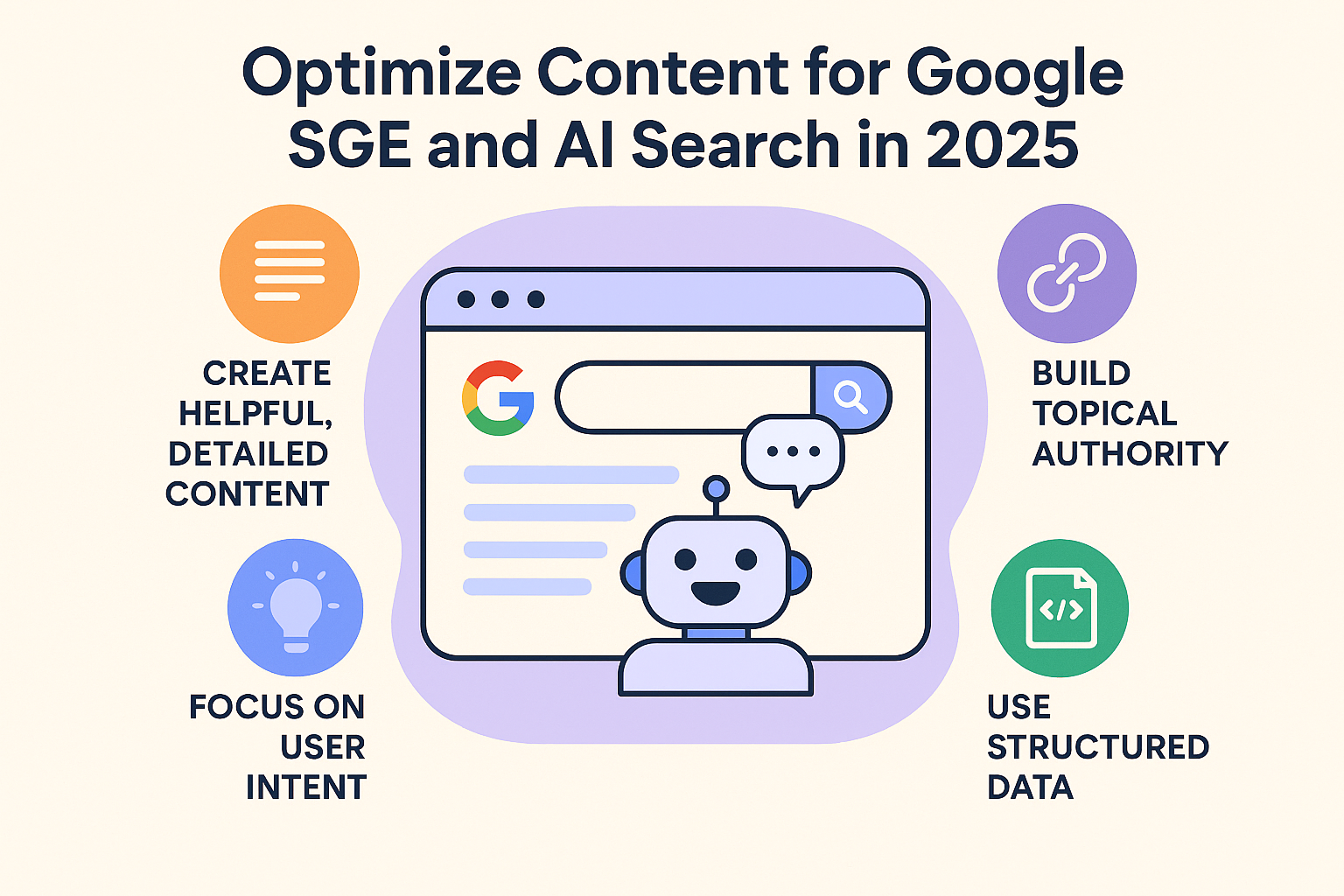Introduction
Search engines are changing fast. Google now offers Optimize Content for Google SGE and AI Search in which SGE, stands for Search Generative Experience. It uses artificial intelligence to give users direct answers. On top of that, AI tools like ChatGPT and Bing Chat are helping people get information in completely new ways.
So, how do you make sure your content stays visible in this new world of smart searches? In this guide, we’ll explain what Google SGE is, how AI search is different, and what you can do to prepare your content. We’ll keep things simple and easy to follow.
What is Google SGE?
Google’s SGE is a smart feature that gives users an AI-generated summary when they search for something. Instead of showing a list of website links, Google may show a box with a clear, helpful explanation written by AI.
Example:
You search for: “Best ways to lose weight in 2025”
Google shows a short answer at the top like:
“Experts recommend balanced meals, fewer sugary foods, and regular exercise. Mediterranean diets are still popular in 2025.”
This is called a summary result. It comes from content across the web, but users may not need to click any links. That’s why it’s so important for your content to be part of the answer.
What is AI Search?
AI search is when tools like ChatGPT, Bing AI, or voice assistants give answers based on what they understand—not just keyword matches. These systems try to figure out what you mean and respond with clear, useful information.
AI search is:
- Smarter
- More natural
- Focused on direct answers
Why You Should Optimize Content for Google SGE and AI Search
People want fast answers. AI and SGE are designed to give them exactly that. If your content is chosen by these tools, your brand gets noticed—even if no one clicks a link.
Benefits include:
- More exposure
- Higher trust from users
- Being shown before regular search results
That’s powerful.
Learn more about search engine optimization and how it relates to AI-driven search.
How would you Optimize Content for SGE and AI Search
Let’s go over clear steps you can take.
1. Answer Questions Clearly
AI and SGE love answers. Write your content like you’re helping a friend.
How to do it:
- Use real questions as subheadings
- Give short, direct answers below
Example: Q: What is Google SGE?
A: Google SGE is an AI feature that shows quick answers in search results using information from different websites.
2. Keep Language Simple
Write the way people speak. Avoid big words or long sentences.
Not helpful: “The paradigm shift in algorithmic responses necessitates dynamic linguistic modulation.”
Helpful: “AI tools prefer clear, simple writing. Keep your sentences short and direct.”
3. Use Headings and Lists
Good structure helps both users and AI understand your content.
Use:
- H2 for big sections
- H3 for smaller topics
- Bullet points and steps for instructions
Why it works:
- Easier to scan
- AI can find answers faster
- Looks better on mobile
4. Add FAQ Sections
FAQs are a great way to cover common questions.
Tips:
- Add 3 to 5 questions
- Keep answers short
- Use schema markup (we’ll explain next)
Example: Q: How do I optimize for voice search?
A: Use full questions, natural phrases, and clear answers in your content.
5. Use Schema Markup
Schema is a bit of code that helps AI understand your page. It doesn’t show on the screen, but search engines use it.
Best types of schema:
- FAQPage
- HowTo
- Article
How to add it:
- Use plugins like RankMath or Yoast (WordPress)
- Use tools like Google’s Rich Results Test to check your schema
6. Build Trust with E-E-A-T
Google and AI tools want to show content that comes from real experts. This is called E-E-A-T:
- Experience: You’ve done what you’re writing about
- Expertise: You know the topic well
- Authority: Others trust you
- Trustworthiness: Your info is safe and reliable
How to show it:
- Add author bios
- Mention certifications
- Link to trustworthy sources
- Share real case studies
7. Update Old Content
Fresh content works better. AI wants current answers.
What to do:
- Add today’s date
- Check and update stats or facts
- Add new FAQs or summary sections
8. Use Long-Tail Keywords
These are full phrases or questions people type or speak.
Examples:
- “How to write AI-friendly blog posts in 2025”
- “What is schema markup for SEO?”
Why use them?
- Less competition
- Better match for voice and AI searches
9. Focus on Usefulness
AI picks content that helps people.
Ask yourself:
- Does this answer a real question?
- Is it clear?
- Would I trust this if I found it?
If yes, you’re doing it right.
10. Use Real-Life Examples
Let’s say you’re writing about coffee. Here’s a good structure.
Title: How to Make Cold Brew Coffee at Home in 2025
Introduction: Quick summary
H2: Ingredients Needed
- Ground coffee
- Filtered water
- Jar or container
H2: Steps to Follow
- Add coffee to the jar
- Fill with water
- Let sit in the fridge for 12–24 hours
- Strain and enjoy
FAQs: Q: Can I use instant coffee?
A: No, cold brew works best with ground beans.
This format is great for AI and SGE.
Final Thoughts
Search is no longer just about keywords. AI tools want to give users the best answers fast. That means your content needs to be clear, helpful, and easy to understand.
If you follow the steps in this guide, you’ll be ready for Google SGE and other AI searches.
Quick Checklist:
- Do all this, and your content won’t just survive the AI future—it will thrive.
Want help optimizing your website for AI search? At SEOwithAI.in, we help businesses get ahead with smart, simple strategies. Let’s grow together.

